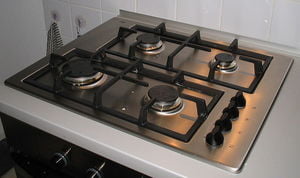If you’re contemplating a kitchen remodel, you’ve probably spent a great deal of time picking out all the elements that will make your space easier and more comfortable to work in and more aesthetically appealing as well.
You may have even spent some time looking at new appliances like refrigerators and dishwashers to compliment your updated space. These power-hungry beasts churn away in the background, and make up a large portion of your home’s energy consumption. But for the eco-friendly consumer, there are many great energy star compliant appliances that will help reduce your carbon footprint and save a pretty penny on your utility bills.
One appliance upgrade that is rarely mentioned however is the range stovetop, and when you’re thinking green the question of whether to use gas or electric power is important in choosing an eco-friendly stove.
Gas Powered Stoves: A Cook’s Friend
Many chefs, from gourmet professionals to “grilled cheese connoisseurs” prefer to use gas stoves because of their ability to quickly and accurately adjust the temperature. Because of this quick response, not only do you have more control over our cooking, but this also means less heat is wasted than in the process of heating and cooling an electric stove’s coiled element. Many newer gas models make use of an electric igniter rather than a pilot light. Using up to 40% less gas, models which use an igniter are a far more energy efficient stove than their older counterparts. .
Gas ranges still aren’t perfect though, because they need to be hooked up to natural gas line. Just remember that when you’re looking for an eco-friendly stove the lower its BTU output, the more environmentally friendly it will be.
Standard Electric Coil Stoves: Energy Wasters
The standard electric coil is probably the least energy-efficient stove on the market. The electric coil that warms your pots takes a long time to heat, and doesn’t respond quickly to temperature adjustments, so you’ll continue to waste heat after you’ve turned it off. The electricity to generate all this wasted heat in the first place most likely was burned in a coal-fired power plant, so the standard electric coil is about the least eco-friendly stove you could buy.
Halogen Element Stoves: A Better Electric Range
With a flat glass or ceramic surface, stoves that use halogen elements easily outperform their standard electric counterparts. Unlike the metal coil which can take a long time to heat up, halogen elements heat up quickly, and respond to a cook’s temperature adjustments quickly, too. Also, the flat surface makes them relatively easy to clean. The drawback is that they only work well when they have good surface contact will your cooking utensils. If the bottom of a pot or pan is rounded, or warped, the halogen stove can’t heat it effectively.
Induction Cooking: The Eco-Friendly Stove
The most energy efficient stove is the induction cooktop, which utilizes the properties of electromagnetism to heat your cookware directly, rather than using a heating element at all. This means that induction stoves have very little wasted heat, respond instantly to temperature adjustments, and are cool to the touch. This means a great deal less wasted energy. In fact, an induction stove can use as little as half of the energy of a standard coil stove.
Induction stoves can be initially expensive, though. Also, many seasoned chefs who are used to gas-powered cooking have a hard time adjusting to the speed with which an induction stove can heat its contents. Also, in order for the induction process to work, you’ll need cookware made from stainless steel or cast iron, which may mean an additional investment. If you already have the proper cookware, or don’t mind upgrading, an induction stove is the most energy-efficient stove on the market.
Decisions, Decisions
Ultimately, the best eco-friendly stove may or may not be the right choice for you, and your decision will likely depend on personal preferences. Whether or not you choose to install an energy-efficient stove, it’s still possible to minimize your carbon footprint by making intelligent choices. Consider your cooking needs and your budget, and make the best choice you can. Whether you choose gas powered, halogen, or induction, your new eco-friendly stove will serve you well.
References:
http://tlc.howstuffworks.com/home/gas-vs-electric-cooking.htm
http://www.state.mn.us/mn/externalDocs/Commerce/Appliances__Electronics_110802035138_Appliances.pdf
http://www.treehugger.com/files/2008/02/how-to-go-green-in-the-kitchen.php






